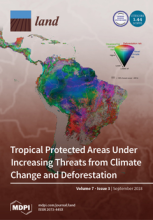Land Library
Welcome to the Land Portal Library. Explore our vast collection of open-access resources (over 74,000) including reports, journal articles, research papers, peer-reviewed publications, legal documents, videos and much more.
/ library resources
Showing items 37 through 45 of 47.This paper explores multi-stakeholder perspectives on the extent to which forestry projects that pursue ecological restoration and rehabilitation in Madagascar engage with local communities and can co-deliver climate-development benefits.
Peatland plays an important ecological and economic role in many countries all over the world. At the same time, due to various human and non-human interventions, peatland is also a fragile ecosystem, which is currently facing severe problems, such as deforestation, fires, and peat subsidence.
Deforestation is recognized as a major driver of the loss of biodiversity and ecosystem services. It also disturbs natural processes such as biogeochemical, hydrological, and ecological cycles.
In this study, methods, originally developed to assess life course trajectories, are explored in order to evaluate land change through the analysis of sequences of land use/cover.
Deforestation and forest degradation (D&D) in the tropics have continued unabated and are posing serious threats to forests and the livelihoods of those who depend on forests and forest resources.
This work aims to provide a comprehensive, wall-to-wall analysis of land use/cover changes in the continental areas of Portugal and Spain between 1990 and 2012.
Identifying protected areas most susceptible to climate change and deforestation represents critical information for determining conservation investments.
The Verified Carbon Standard (VCS) recommends the Figure of Merit (FOM) as a possible metric to confirm models that simulate deforestation baselines for Reducing Emissions from Deforestation and forest Degradation (REDD).
In Indonesia, land cover change for agriculture and mining is threatening tropical forests, biodiversity and ecosystem services. However, land cover change is highly dynamic and complex and varies over time and space.





